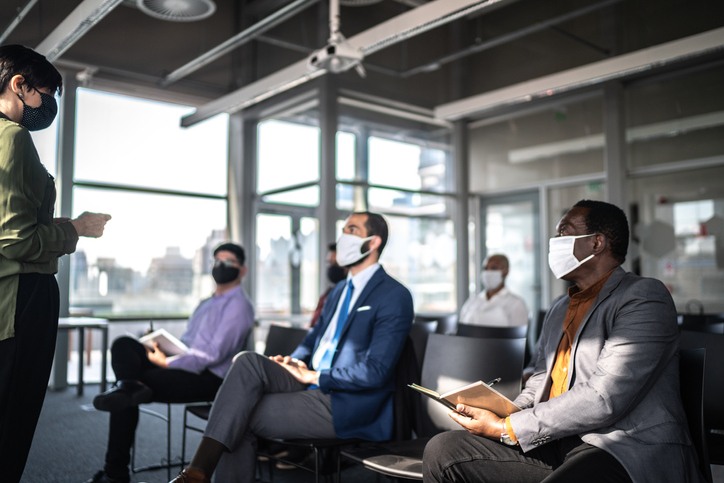The Hybrid Event Experience
Hybrid meetings and events will lead the way in early 2021 as we slowly make our way back to engaging in-person. But what does the hybrid experience look like? Here, two BCD M&E leaders share their attendee journey through recent hybrid events that took place in Asia Pacific.
Attending a hybrid event in-person

“It’s taken a lot of time and a lot of effort, but we are in a much better place now which allows the hybrid experience to happen.”
The management of COVID-19 in Singapore, where the events I attended were hosted, is in a very good place right now. It has been well controlled and currently we are close to almost zero local cases. It’s taken a lot of time and a lot of effort, but we are in a much better place now which allows the hybrid experience to happen, with some people coming together.
On-site safety
I would say it absolutely feels safe to attend the live portion of a hybrid event now. I’ve been fortunate to attend a couple of these types of meetings and the latest one involved 10 different markets with attendees from 5 of them attending the meeting live and 5 attending virtually. People are eager to get back to doing what we do best, and with all of the necessary safety precautions in place, I’m happy to see it becoming reality.
At the events I attended, there were many safety protocols in place. We were sat with proper safe distances apart, everyone wore masks and everything from our meals were served to us individually which worked extremely well.
From the time I arrived, it was clear the event producers had considered how to minimize direct contact with others throughout the registration process. Pouches for lanyards were laid on a table with someone standing behind a table directing you to take one yourself once you had printed out your label and then directed you to your specific zone for testing. The limited interaction was focused on ensuring that we followed protocols for safety while ensuring the flow was clear. From that perspective, it made me feel very confident and very safe.
Engagement
Although it looked different, we all still managed to participate and engage during breakout brainstorms where we shared our ideas. Across the board, people were genuinely engaged which I think shows that hybrid events are becoming more regular and participants understand and are comfortable with this new way of meeting.
Networking opportunities
There was a bit of a challenge to socialize while staying appropriately distanced, but for example when we broke out into groups, we were seated in a circle formation to give enough space. I don’t believe there was any hindrance to the experience in my view, but it was hard not to reach out to say hello to someone you knew in the next zone at registration!
Pros and Cons of Hybrid Events
-
Successes
The successes of hybrid events are that we see them as a reflection of the industry getting closer and closer to a time when live meetings become more of the norm. This year has forced people to educate themselves and shown ways in which we can do things differently, smarter, more lean, more economical. My feeling is that some of the things we are doing right now-like new practices we have embraced-are not going to go away just because it’s safe to travel. Customers’ mindsets are already ahead of the game in terms of what they might do in the future. The new normal is not going to be the same as what it was before, that’s for sure.
Related article: 7 Success Factors for Hybrid Events
-
Struggles
I would say that while you are together, you really have to respect the safety protocols that are in place for social distancing which is not always easy. But if we keep to those rules, there will continue to be traction for these types of events and more people are going to feel safe attending.
I think the struggle that we have right now is that when you do a hybrid event you’ve got both elements (live and virtual) which means costs are not going down. However, I think as more sustainable practices are implemented, there will be opportunity for these types of events to evolve.
Watch as Fernando Lonergan, Senior Director of APAC at BCD M&E
tells how it feels to attend PCMA‘s first hybrid event.
Attending a Hybrid Event Virtually
What are the pros and cons of the hybrid event experience for those that join virtually? Here, Andrew Yeo, Director of Technology, APAC provides his point of view on joining a recent event:
Overall, the hybrid event that I attended virtually was a success. The online registration process was straightforward and the agenda was easy to navigate.
They managed to invite two panelists from overseas who joined virtually and the speakers were shown via floating panels on stage. Instead of the traditional PowerPoint presentation, they used a large LCD screen beside a speaker to project the slides which made it much more interesting to view.
I think the event went smoothly virtually without any hiccups. Although virtual attendee engagement was limited, one way that they did involve the virtual audience was by launching a QR code for online surveys which allowed people to engage in real-time. The only thing I will comment on is the duration, as it was two and a half hours long and could be taxing on attendees attending virtually.
Originally published Dec 14, 2020 2:09:39 PM
Last updated on Jan 3, 2023 11:52:07 AM


